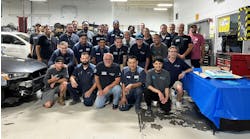DETROIT (April 18, 2007) — According to the latest statistics from the National Highway Traffic Safety Administration (NHTSA), nearly 5,000 pedestrians were killed by vehicles in the United States in 2005 — and almost three-fourths of these deaths occurred in urban areas.
To address this issue, Continental Automotive Systems (CAS) announced at the Society of Automotive Engineers (SAE) World Congress that it has developed an optical sensor that can help a driver reduce the severity of or completely avoid collisions when traveling at speeds less than 25 miles per hour. The company is planning to launch the system next year with one of its European customers.
Crash avoidance in action The company developed the closing velocity (CV) sensor system to help reduce crashes in high-stress urban traffic situations by deploying an enhanced brake assist and enabling crash-avoidance strategies. This precrash system scans the space in front of the vehicle up to approximately 10 meters in three areas: to the right, the left and straight ahead.(Photo: Continental AG)
During the development of the system, it was demonstrated that these measures in combination could assist drivers avoid a crash, which could help reduce the number of collisions in urban traffic. Once the CV sensor detects another vehicle, motorcycle, bicycle or pedestrian ahead, it sends a signal back to a "transceiver" that is mounted near the rear view mirror. The transceiver then uses the signal to calculate the distance of the object in front of the vehicle along with its closing speed. If the distance between the vehicle or pedestrian is closing so quickly that a collision is imminent, the system responds as follows:
* The brakes are put on alert mode, and sufficient pressure is built up in the braking system so the brakes can respond as soon as the driver applies the brake pedal (prefill).
* If the driver takes his or her foot off the accelerator, the precrash system initiates automatic braking at up to 0.5 g (prebraking).
* If the driver operates the brake pedal, but with too little sustained pressure, the intervention of brake assist ensures the maximum possible braking power.
* For further driver protection function, if needed, the system can also pretighten the seat belts.
Win-win benefits Once a CV sensor and precrash system is integrated into a car, the system provides benefits for all road users, from car manufacturers to the public. Because the risk of a crash is significantly lower, driver, passenger and pedestrian safety is enhanced, says CAS. Should a crash occur, vehicle occupants will be better protected against injury because seat belts will be tightened to the optimum degree.The CV sensor also will provide data to the airbag control unit, enabling it to better respond by assessing the extent of an impact and activating an airbag if needed. Vehicle repair and medical costs for all involved parties are also likely to be significantly lower because the resulting collision will be less severe. This new sensor provides the automotive industry with a system that makes precrash functionality affordable even for small and mid-range vehicles, thus ensuring that nearly the entire vehicle market can benefit.
"We strongly believe that such comprehensive safety systems should be made available to all vehicle categories. The CV sensor is easily integrated into the vehicle electronics and does not require any adjustment to the vehicle structure," explains Dr. Ralf Cramer, head of the business unit electronic braking and safety systems at CAS.
"The new sensor system is yet more evidence of our strong position in terms of developing and manufacturing safety systems that are priced attractively enough for use in cars below the luxury range,” Cramer adds.
The CV sensor highlights the functionality of Continental's Active Passive Integration Approach (APIA) project, which combines active and passive safety for mass-market vehicles.
(Source: Continental Automotive Systems)


